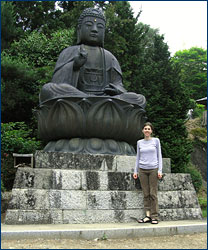
Jann visits with Buddha at a Rikuzen-Takata temple. Click on any photo on this page to see an enlargement.
Researching whelks in Japan: Field notes from Jann Vendetti
By UCMP grad student Jann Vendetti, July 1–4, 2008
 Jann visits with Buddha at a Rikuzen-Takata temple. Click on any photo on this page to see an enlargement. |
| Sponsored by the NSF (National Science Foundation) and the JSPS (Japanese Society for the Promotion of Science), Jann is studying fossil and living whelks — a type of snail — in Japan, the home of more than one third of all extant whelks. Jann is interested in the evolution and dispersal of whelks through time and in their different modes of developmental growth. For more photos and more details of Jann's adventures in Japan, visit her blog. |
July 1, 2008
After a combined travel time of six hours on the Shinkansen (bullet train) and Japanese Railway, my Japanese host Seiji and I arrived in Rikuzen-Takata, a town in the south of the northern Honshu prefecture (or province) of Iwate. The name "Takata," which means rice paddy, was appropriate because paddies were plentiful. Rikuzen-Takata is home to the Museum of Sea and Shells, a public museum devoted entirely to mollusks. About 20,000 people visit the museum each year, and it boasts impressive shell displays, two live Nautilus (I thought that they were fake until I saw them swim!), and a "tour through time" exhibit depicting the evolution of marine life since the Cambrian Period. The reason that I came here, however, was not the impressive public exhibits, but the shells in the museum's collections. This museum houses 35 North Pacific buccinid gastropod holotype and paratype specimens, all described by the Japanese malacologist R. Tiba in the 1980s. Holotypes are the original specimens from which the species description was made. Paratypes are designated specimens that show off the diversity that is found within the described species. Because these are important specimens, they are often housed in secure rooms and require special permission and sometimes a curator's supervision to view and examine.
I was lucky to be able to examine all the whelk type specimens in this museum — and I even got to make molds (impressions in silicon) from the 53 species in the museum's large gastropod general collection. I was particularly interested in molding the pointy tip of the snail shell — the protoconch. Why are protoconchs so interesting to me? Because as a snail grows, it adds new shell to its leading edge (along the opening where the animal can stick its head and foot out) — which means that one snail shell contains a whole history of the animal's growth, from its larval self to its adult self. The very top (the protoconch) is what the shell looked like when it was essentially a "baby." From the size and shape of that protoconch, one can learn about the snail's early development.
I would be spending the night at a ryokan across the street from the museum. A ryokan is a traditional Japanese hotel or guest house that is different from a Western style hotel in a couple of ways. First, your room has a tatami (woven reed) floor on which only feet (bare or in socks) are allowed. There is no bed, per se, but a futon folded up in a closet that is laid out for you to sleep on. Also, an onsen (Japanese soaking tub) is often on the main floor and there you can relax and soak in very hot, steamy water after a long day of searching for, photographing, and molding snail specimens.
I ate dinner at a local udon (wheat noodle) shop and bought breakfast and lunch from the local convenience store called Family Mart. This particular Family Mart was remarkable in that it carried a very interesting item: Rhinoceros beetles! This species, Trypoxylus dichotomus, is a common pet for Japanese children and a "gambling chip," so to speak, for adults who buy, trade, sell, and bet on these large insects in "fights" with other beetle opponents. I was somewhat surprised at the popularity of beetles as pets. They are nothing like my childhood pet of choice, Mesocricetus auratus (a hamster).
July 4, 2008
After a few days of museum work, I was antsy to explore Rikuzen-Takata, especially because it was my first opportunity to experience non-urban Japan. The museum curator, Masuru Kumagai, helped me rent a bicycle and I headed for the hills … and shrines, and temples. I was amazed at the amount of land used for rice paddies and pear orchards. I noticed several tsunami warning signs and announcement loudspeakers — reminders of the very real threat of such a disaster. On May 23, 1960, a tsunami generated by the Great Chilean Earthquake damaged the town and much of the surrounding area.
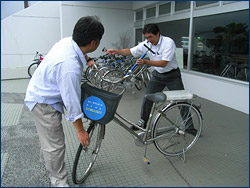 |
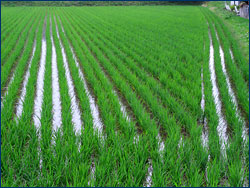 |
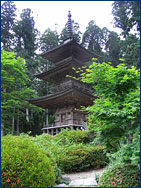 |
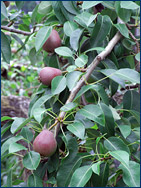 |
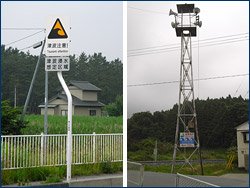 |
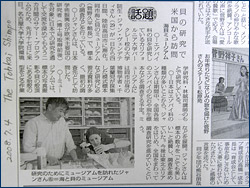 |
||
| Top left: Museum curator, Masuru Kumagai (left), makes sure that Jann's rental bike has fully inflated tires. Top center: A closer view of a rice paddy. Top right: One of the temples that Jann visited on her bike ride. Bottom left: Jann passed by many a pear orchard. Bottom center: Tsunamis are a very real threat to this coastal city — Jann saw several warning signs and loudspeaker towers. Bottom right: An interview with Jann appeared in this July 4 newspaper article. | ||||
When I returned from my long bike ride, exhausted but exhilarated (and wet from the rain), I was excited to learn that the interview I gave to a local newspaper, The Tohkai Shimpo, had been printed. Somewhere in the text it might mention UC Berkeley and/or the UCMP — but alas, I cannot read Japanese!
Watch for Jann's next report from Japan!
All photos by Jann Vendetti.